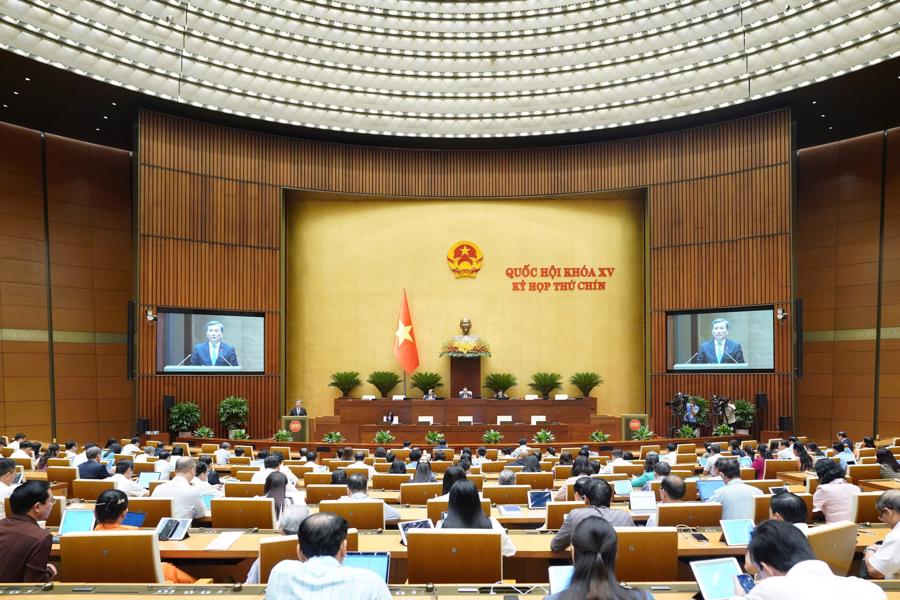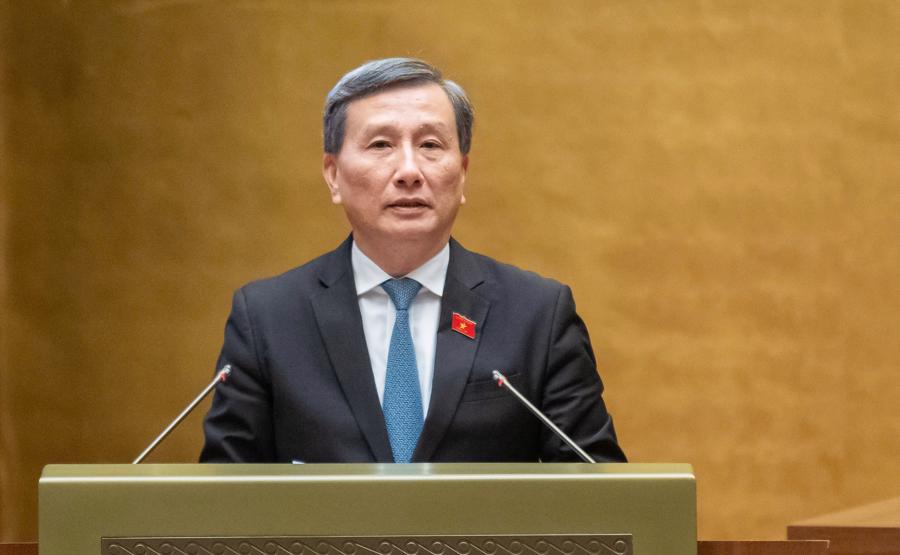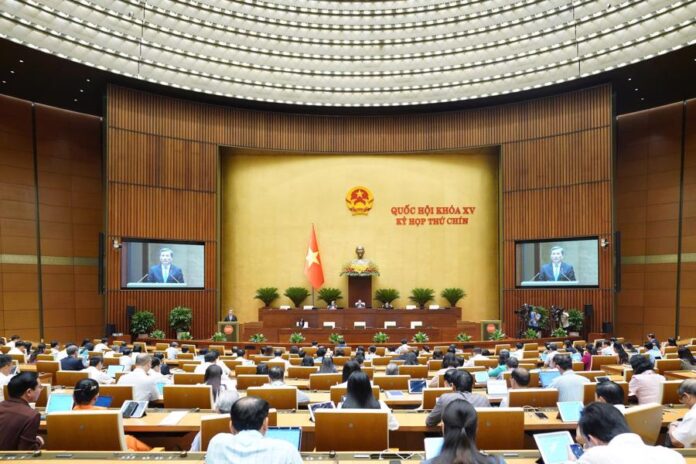The National Assembly continued its working program on May 8th, with Le Quang Huy, Chairman of the Committee for Science, Technology, and Environment, reporting on the explanation, adoption, and amendment of the draft Law on Chemicals (amended). The National Assembly also discussed this content.
According to the report of the National Assembly’s Standing Committee, many delegates suggested studying, reviewing, and institutionalizing a number of Party guidelines related to the roadmap for banning the use of harmful chemicals that pollute water sources. They also emphasized the need to promote green transition, circular economy, and equitable energy transition. This includes the implementation of Resolution No. 57-NQ/TW of the Politburo on breakthroughs in science and technology development, innovation, and national digital transformation, as well as Resolution No. 18-NQ/TW on continuing to renew and rearrange the organization of the political system to be more streamlined and efficient, with decentralization and delegation of authority in chemical management.
PROJECTS ARE EXPECTED TO APPLY AT LEAST ONE GREEN CHEMISTRY PRINCIPLE
Regarding the above content, the report of the National Assembly’s Standing Committee stated that the draft Law has included some provisions to institutionalize the content of “Building and deploying a roadmap to ban the use of harmful chemicals that pollute water sources” in Conclusion No. 36-KL/TW. These include regulations on chemical management, and provisions on the safe distance from chemical production and storage areas to freshwater extraction areas (Article 37). These regulations aim to minimize the negative impact of chemicals on water sources.
The draft Law has also included provisions to institutionalize the content of “promoting the implementation of green transition, circular economy, and equitable energy transition.” This includes applying green chemistry principles in the design and selection of technology and equipment (point d, clause 2, Article 7).
Article 7 of the draft Law stipulates that investors in chemical projects have the obligation to apply green chemistry principles in the design and selection of technology and equipment. The application of green chemistry principles is also included in the feasibility study report, the economic-technical report, or equivalent documents.

In addition, the set of green chemistry principles will be specifically defined by the Government as a basis for application in the design, production process, use, and disposal of chemicals. This will help to minimize or eliminate the use and creation of hazardous chemicals, ensuring feasibility in implementation.
The draft Law has added Clause 5, Article 7, which assigns the Government to detail the chemical project’s content, including the application of green chemistry principles. At the same time, it removes the regulation assigning the Ministry of Industry and Trade to define the set of green chemistry principles (Clause 19, Article 2). This content is expected to be detailed in the Decree guiding the implementation of the Law, with a direction to require projects to apply a minimum of one green chemistry principle.
To concretize the contents mentioned in Resolution No. 29-NQ/TW, the draft Law stipulates key sectors of the chemical industry, including basic chemicals, petrochemical products, pharmaceuticals, fertilizers, investment projects in specialized chemical industrial parks, and chemical complexes, to promote green growth and circular economy (Article 8).
Moreover, during the Law’s drafting process, the authoring agency organized numerous workshops and consultations with the business community, experts, scientists, practitioners, and affected entities. They have also proposed solutions to remove bottlenecks in the development of the chemical industry and chemical management, such as managing chemicals throughout their life cycle and managing hazardous chemicals in products and commodities.
Regarding the prevention of chemical accidents and their impact on the environment, the draft Law has provisions in Chapter VI on chemical safety. These provisions clearly state that chemical production and storage facilities must comply with regulations on physical and technical conditions to ensure safety in chemical-related activities. It also includes regulations on plans and measures to prevent and respond to chemical accidents, ensuring compliance with safe distance regulations and providing chemical safety training.
In addition, Chapter VII of the draft Law stipulates the responsibilities of organizations and individuals related to chemical activities, including the protection of the environment and community safety.
DEVELOPING A PLAN TO PREVENT AND RESPOND TO CHEMICAL ACCIDENTS
Regarding the development of a plan to prevent and respond to chemical accidents, some opinions suggested studying and re-evaluating the basis and feasibility of the regulations on the chemical accident prevention and response plan. This is to ensure smooth and effective implementation in practice and alignment with the Law on Civil Defense, the Law on Environmental Protection, and the Law on Occupational Safety and Hygiene. It was also suggested to review the Law on Environmental Protection to integrate the chemical accident response plan with the environmental accident response plan.
On this issue, the Standing Committee of the National Assembly expressed the view that the development and appraisal of the chemical accident prevention and response plan, in accordance with the Law on Chemicals of 2007, has contributed to enhancing the capacity of chemical accident response forces. It has also helped to minimize the occurrence of chemical accidents and reduce their consequences. The provisions of the draft Law have been reviewed and are consistent with relevant laws.

Regarding the integration of the chemical accident prevention and response plan with the environmental accident response plan, the Standing Committee of the National Assembly analyzed that there are some differences between the two plans. In terms of scope, according to environmental protection laws, all project investors, organizations, and individuals involved in chemical activities are responsible for developing an environmental accident response plan. However, according to the draft Law on Chemicals (amended), only project investors, organizations, and individuals involved in the storage of hazardous chemicals above the threshold are required to develop a chemical accident prevention and response plan.
Therefore, the integration of the two types of plans, if applicable, would only apply to project investors, organizations, and individuals involved in the storage of hazardous chemicals above the threshold.
The scope of the environmental accident response plan is very large and may be wider than the scope of the chemical accident prevention and response plan. In reality, at facilities involved in chemical activities, environmental accidents can occur that are not related to chemical accidents (for example, the dam break accident at the Vinachem No. 2 DAP Company’s waste ash dump). Therefore, when integrating the two types of plans, the specialized agency for chemicals will have to appraise the contents related to the environmental accident response, which may not be truly suitable and could limit the quality of the appraisal.
In terms of professional and technical requirements, the chemical accident prevention and response plan requires in-depth technical and professional measures in chemistry, chemical technology, hazardous waste management, and occupational safety and health in handling incidents related to chemicals.
On the other hand, implementing the environmental accident response plan requires knowledge and skills not only related to chemicals but also in other fields such as ecosystem restoration, environmental pollution treatment, consideration of other impacts such as noise and emissions, and analysis of long-term impacts on the environment.
Integrating or combining the two plans may fail to meet the detailed and specialized requirements of each plan, affecting the quality of response and prevention work. Given the above analysis, the National Assembly’s Standing Committee proposed to the National Assembly to maintain the draft Law as it is, Mr. Huy informed.
To ensure no overlap with the concept of “pharmaceuticals” as medicines and raw materials for medicine production, Clause 10, Article 2 of the draft Law has been amended as follows: “Chemical pharmaceuticals are chemicals used as raw materials for medicine and health supplement production, created through chemical processes, extraction of natural compounds, or biological processes.” According to Clause 3, Article 8, projects on chemical pharmaceuticals will be eligible for special incentives and support.
“Proposal to Exempt Small Air Conditioners from Special Consumption Tax and Reduce Tax Increase on Pickup Trucks”
Air conditioners with a capacity of less than 18,000 BTU and over 90,000 BTU are expected to be exempt from taxes, while gasoline remains subject to special consumption tax.
“Proposal to Merge Provincial-Level Administrative Units: A Comprehensive Reform for Efficient Governance”
The National Assembly will discuss a range of critical issues at its 9th session, including resolutions on mechanisms and policies to foster private economic development. Additionally, a pilot scheme will be proposed, offering special mechanisms and policies to invest in developing the railway system. A proposal for the merger of provincial-level administrative units is also on the agenda, alongside other significant matters.
The Magic Number: Why 60 is the Perfect Headcount for Each Administrative Unit
“In a recent development, Minister of Home Affairs Pham Thi Thanh Tra announced the completion of the overall plan for the rearrangement of administrative units at the provincial and communal levels. This plan is now ready to be presented to the National Assembly for their consideration. As per the proposed rearrangement, it is anticipated that each ward, commune, and special district will have an average temporary staffing allocation of 60 individuals.”
Unblocking the Institutional Bottleneck: Unleashing the Flow of Business
The business community is yearning for a more substantial reform mindset. This goes beyond merely reviewing and amending existing regulations; it entails a fresh approach to crafting new policies that are open, transparent, and business-friendly.





















